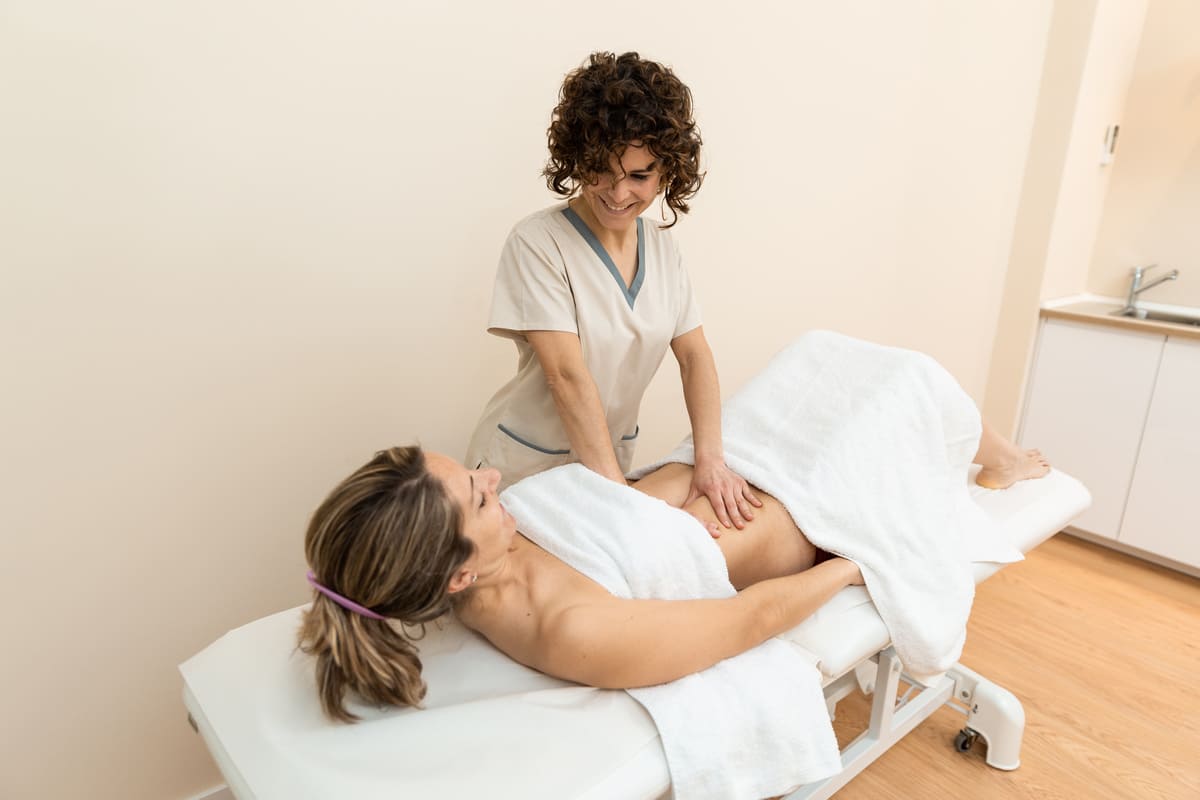Bringing a new life into the world is a beautiful, transformative experience, but it can also leave new mothers feeling physically and emotionally drained. The body undergoes incredible changes during pregnancy and childbirth, and the postpartum period—those weeks and months after delivery—can be just as challenging.
Many women turn to prenatal massage during pregnancy to ease discomfort, but did you know it can also play a significant role in postpartum recovery? How does prenatal massage, and its postpartum continuation, help new moms heal, relax, and regain their strength? Read on to find out.
In This Article
What Is Prenatal Massage?
Prenatal massage is a gentle, therapeutic technique designed specifically for pregnant women. It uses soft strokes and safe positions to relieve common pregnancy discomforts like back pain, swollen feet, and stress. Trained therapists who provide massage therapy during pregnancy know how to support the body’s changing needs, avoiding pressure points that could be risky during pregnancy.
While prenatal massage is tailored for pregnancy, its techniques can be adapted for the postpartum period, often called postpartum massage. This continuation focuses on the unique needs of a body recovering from childbirth. It’s a soothing bridge between pregnancy and the new demands of motherhood.
So, how exactly does it help in the postpartum phase?
Easing Muscle Tension and Soreness
Pregnancy puts a lot of strain on the body. Carrying extra weight for months can tighten the soft tissues of the muscles in the back, hips, and shoulders, thereby causing hip pain or sciatic nerve pain. Childbirth, whether vaginal or cesarean, adds even more stress to these areas. Prenatal massage therapy, when used postpartum, help loosen those tight spots.
For example, a therapist might use gentle kneading to relax the lower back, which often bears the brunt of pregnancy weight and labor. This can make a big difference for new moms who feel stiff or sore while adjusting to breastfeeding, carrying a baby, or recovering from delivery. By releasing muscle tension, massage helps moms move more comfortably, making daily tasks like lifting a car seat or rocking a baby feel less taxing.
Boosting Circulation for Faster Healing
One of the less obvious but powerful benefits of prenatal massage is its ability to improve blood flow. During pregnancy, the body produces extra blood to the blood vessels to support the baby, and after delivery, swelling (edema) in the legs, ankles, or hands can linger. Massage encourages circulation, which helps reduce this swelling and delivers oxygen and nutrients to tissues that need repair. It also helps reduce the risk of pregnancy-induced hypertension.
Improved blood flow can support the healing of the incision site for moms recovering from a cesarean section, though therapists avoid direct pressure on surgical areas. Even for vaginal deliveries, better circulation helps the body recover from stretched ligaments and strained muscles. It’s like giving your body a gentle nudge to heal more efficiently, which is especially helpful when you’re juggling the demands of a newborn.
Reducing Stress and Anxiety
The postpartum period can feel like an emotional rollercoaster. Hormonal shifts, sleep deprivation, and the pressures of caring for a newborn can leave moms feeling overwhelmed or even anxious. Prenatal massage techniques, when used postpartum, help calm the nervous system by lowering cortisol—the stress and anxiety hormone—and boosting endorphins, the body’s natural ‘feel-good’ chemicals.
Imagine sinking into a quiet, soothing massage session after a long day of diaper changes and feedings. That moment of calm can be a lifeline for new moms. Studies suggest that regular massage can reduce symptoms of postpartum depression, though it’s not a replacement for professional mental health care. By creating a space for relaxation, massage helps moms recharge emotionally, making it easier to handle the ups and downs of early motherhood.

Supporting Pelvic and Postural Recovery
Pregnancy and childbirth can throw the body’s alignment out of whack. The pelvis, in particular, takes on a lot of stress as it widens to prepare for delivery. After birth, some women experience pelvic discomfort or feel ‘off-balance’ as their body adjusts. Prenatal massage techniques, adapted for postpartum needs, can gently support pelvic balancing and ease tension in the hips and lower back.
For example, a therapist might use light stretching or targeted pressure to relax tight pelvic muscles. This can be especially helpful for moms who feel lingering discomfort from labor and birth or who are adapting to new postures, like hunching over during breastfeeding. By addressing these structural issues, massage helps moms feel more grounded and balanced as they navigate their new normal.
Safety and Timing
While prenatal massage techniques are incredibly beneficial, safety is key. Postpartum massage should only be done by a certified therapist trained in prenatal and postpartum care. They’ll know how to avoid sensitive areas, like a C-section scar, and use techniques that are gentle yet effective.
Timing matters too. Most experts recommend waiting 4–6 weeks after delivery before starting massage, especially for cesarean recoveries or complicated births. Always check with your healthcare provider first to ensure it’s safe for you. Once you get the green light, a therapist can tailor the session to your specific needs, whether it’s focusing on your sore shoulders or helping with swelling.
Why It’s Worth Trying
So, why consider prenatal massage techniques for postpartum recovery? It’s more than just a luxury—it’s a practical way to support your body and mind during a transformative time. From easing sore muscles to reducing stress and supporting healing, the benefits of maternal massage add up to a smoother recovery. Plus, it’s a chance to carve out a little ‘you’ time, which can feel like a gift when you’re in the thick of motherhood.
If you’re curious about trying it, talk to your doctor and look for a licensed massage therapist with prenatal and postpartum training. They can guide you on what feels right for your body. Every mom’s recovery journey is unique, but prenatal massage offers a gentle, effective way to feel stronger, calmer, and more like yourself again.











